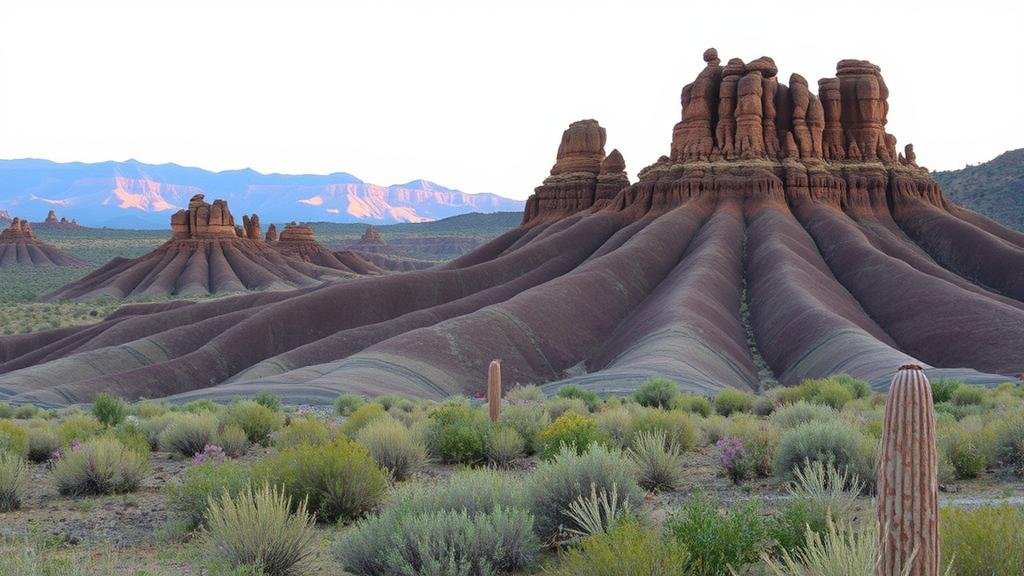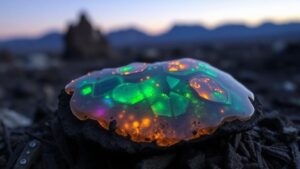Searching for banded rhyolite formations in the volcanic fields of the Gila Wilderness.
Searching for Banded Rhyolite Formations in the Gila Wilderness
The Gila Wilderness, located in southwestern New Mexico, is a geological wonder that draws rockhounds and mineral collectors seeking beautiful and unique formations, including banded rhyolite. This article provides an in-depth look at what makes these formations special, where to find them, and tips for collectors eager to expand their collections.
What is Banded Rhyolite?
Banded rhyolite is a type of volcanic rock characterized by its striking layers and bands of colors, often ranging from white and gray to rich reds and purples. These striking elements make it a sought-after material for ornamental use and personal collections. Rhyolite forms from the rapid cooling of lava that is high in silica, typically erupted from a volcanic dome or lava flow.
The bands in rhyolite result from variations in the mineral composition as well as changes in temperature and pressure during the volcanic eruption. The textures and patterns can be compared to a fingerprint, making each specimen unique.
Geological Significance of the Gila Wilderness
The Gila Wilderness is part of the larger Gila National Forest and hosts some of the most ancient volcanic activity in the southwestern United States. It features a diverse landscape with rugged mountains, deep canyons, and fertile river valleys. region underwent significant volcanic activity around 20 million years ago, leading to the formation of various volcanic structures, including the banded rhyolite found today.
According to the New Mexico Bureau of Geology, the Gila Wilderness is home to some of the best-preserved volcanic rock formations, making it a prime area for geological studies as well as rock hounding.
Where to Find Banded Rhyolite
Collectors interested in banded rhyolite should focus their efforts on specific locations within the Gila Wilderness. Here are some promising sites:
- Middle Fork Gila River: This area is known for its abundance of diverse rock types, including banded rhyolite.
- Gila River Trail: Following this trail often reveals outcrops where rhyolite is exposed alongside sedimentary rocks.
- Mineral Creek: The banks of this creek are rich in a variety of geological specimens, making it a hotspot for collectors.
Before heading out, it is advisable to obtain a topographical map or use a GPS device to navigate the area with accuracy. Collectors should also consult local geological surveys and park services for updated information on rockhounding regulations.
Techniques for Collecting Banded Rhyolite
When searching for banded rhyolite, consider employing the following techniques:
- Surface Exploration: Search for loose rocks along trails and water bodies where erosion reveals underlying layers.
- Prospecting in Outcrops: Examine vertical outcrops by carefully removing loose debris to expose fresh rock surfaces.
- Utilizing Tools: Equip yourself with a rock hammer, chisel, and safety goggles to effectively and safely collect specimens.
Pay attention to the weather and safety regulations in the area since conditions can change rapidly in wilderness settings. Always inform someone of your plans before you go out.
Preserving and Caring for Your Collection
Once you’ve successfully collected banded rhyolite, it’s crucial to preserve your specimens properly:
- Cleaning: Use a gentle brush or cloth to remove dirt. Avoid harsh chemicals or high-pressure water that can damage the surface.
- Storage: Store rocks in a cool, dry place to prevent moisture and temperature fluctuations from causing cracks or deterioration.
- Documentation: Keep detailed notes about where each piece was collected, its geological context, and any relevant observations.
Taking these steps ensures that your collection remains vibrant and valuable over time.
Real-World Applications
Banded rhyolite is not just a collectors item; its unique beauty makes it popular in jewelry making and decorative arts. Artists and designers frequently utilize the vibrant colors and striking patterns in their creations. mineral composition can also provide insight into the environmental conditions during the time of its formation, allowing geologists to better understand volcanic processes.
Conclusion
The Gila Wilderness offers a remarkable opportunity for rockhounds and mineral collectors to discover the allure of banded rhyolite formations in their natural habitat. By understanding the geology, utilizing effective collecting techniques, and preserving your finds, you can enhance both your collection and your appreciation for these striking natural creations.
As you venture into the Gila Wilderness, remember the importance of respecting the environment and following all local guidelines. Happy hunting!

